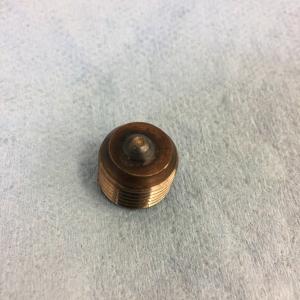
Oil temprature sensor location Hayabusa RPE 1340 or 1500 dry sump
I am toying with putting the dry sump kit on my SR1. maybe over the next winter. one thing that has me wondering is where is the oil temp sensor? currently, on the wet sump, it is in the side of the oil pan, submerged in oil. since i would like to know what the maximum oil temperature is, having it installed in the dry sump tank, wouldn't be good enough because it is after the oil cooler. my thought is that it should be in the oil line going to the cooler. I searched the internet for the answer, but came up empty. a photo is always welcome.
The standard setup is to have the oil temp sensor in the dry sump tank. Here is a picture that should help. I am not sure why Radical chose this location, but it has proven to work well over time. Also, the temperature ranges that Radical specifies assumes that the temp. sensor is in the dry sump.
Charley
As Charley says the dry sump tank has oil temp in the tank.
Dry sump plumbing is different and all oil runs through the oil cooler before returning to the oil tank, this means the oil temp you read is what is being fed to the engine and the temp you need to know.
Wet sump runs with separate oil cooler as per the road bike.
Thanks for the clarification on the location.
I know the debate of sensor location has been beat to death on other sites. But why is the operating range the same, 90-110C ? Oil measured at the sump has to be hotter than oil after it has gone thru the cooler and into the tank. One would think the range and limits would be different for wet sump vs dry sump.
I think it is important to ensure that you are reading the temperature of the oil that is being fed into the engine.
On a wet sump the oil in sump pan is what is being picked up and fed into the engine. With the dry sump it is the oil in the tank that is being fed into the engine.
The oil cooler on the wet sump system using the standard road bike fittings and not all of the oil is cooled. All oil that is cooled should be returned to the sump.
On my car, the oil path is: sump-press pump-cooler-filter-galley/parts-back in sump.
So the oil temp is measured after it has removed heat from the parts and before it goes into the cooler. We don’t know what the temp of the oil is that is being fed into the engine.
A dry sump does measure the temp of the going into the engine, after it has been through the cooler and in the tank. But we don’t know what the temperature of the oil was as it was in the sump, how ever brief that is.
The problem is the oil coming out of the sump is 50% air, because that’s how a scav pump works, and it’s not easy to measure the temperature of “foam”
So if we use the same target of say 220f, because the senor is located, one before and one after the cooler, each engine will have a different maximum oil temperature.
Just food for thought, knowing this won’t change anything.
I agree to extent, if you look behind the oil filter on your engine you will notice a allan headed restrictor jet. This forces an amount of oil around the oil cooler but also means that some oil cooler goes straight through the pump and then oil filter into your engine. Due to this the oil temp is'nt as accurate as the dry sump.
With the dry sump the oil does not really spend any time in the sump pan. The feed from the tank goes straight into a machined gallery that leads directly into the pressure pump, the temperature will increase very little before going through the pump, but the oil is not spending any time being stored in an open sump pan. Having a temp sensor just before the pressure pump would take some work and be a pain to replace if you have a sensor go down. Dry sump oil temp is at the bottom of the tank, so it has been through as many de-aeration process that the tank can offer and due to the amount of oil capacity it should be fairly accurate.
As you say its all food for thought and an interesting discussion point.
Bringing this back, adding a data point.
I did buy a dry sump kit from Dan, thanks Dan. It will be installed at the end of my refresh.
My sensor is going to be installed in the oil tank, like all the others.
Dan here is a photo of the Allen plug behind the oil filter, the jet/restrict has been welded closed, thus all the oil from the pump went thru the oil cooler.
if I can, I will put a second sensor in the unused plug in the scavenge pump. That way I can measure the temperature of the oil as it leaves the engine, maybe seeing what the maximum temperature that the oil reaches.
No problems, appreciate the order!
I do recall now, wet sump engines in an SR1/4 having a blanked oil jet to ensure a decent level of oil cooling.
Just make sure that you leave that jet out on assembly.
Will be interesting to see the temp difference and if you have an increase in oil pressure.
Sure you will see it but just make sure the sensor in the scavenge pump doesn't protrude into the rotors of the pump!



